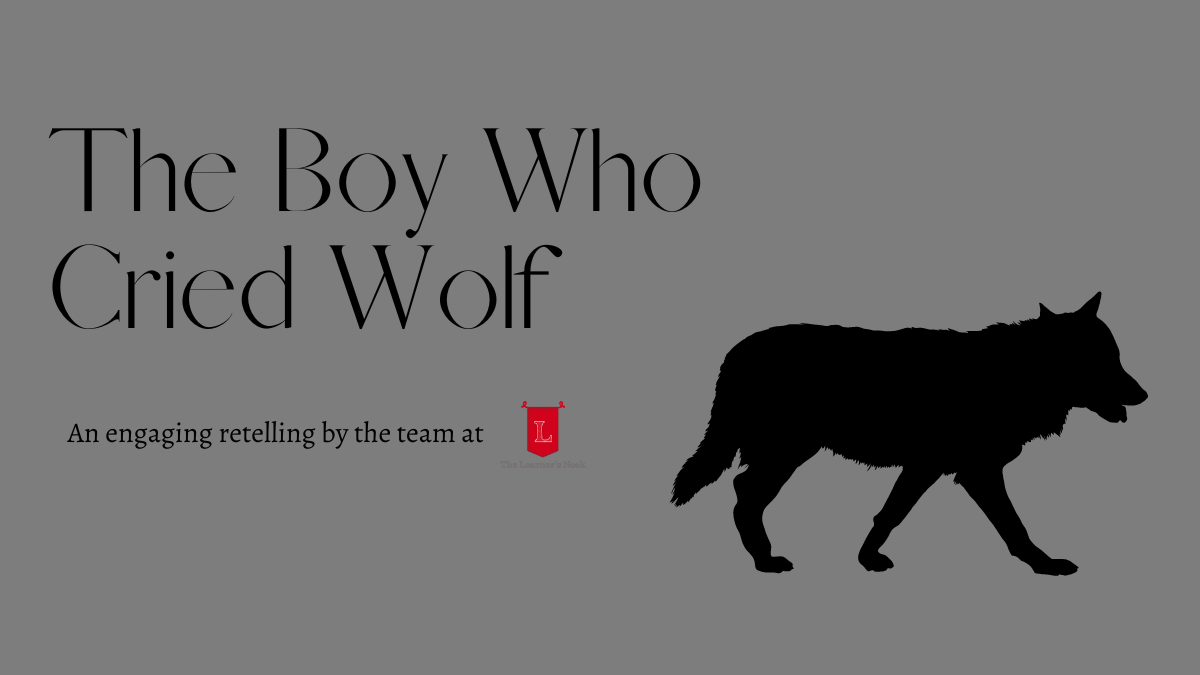The story of the boy who cried wolf is a classic tale that is meant to teach children about the problems with lying. Our version of this story has been simplified, so it is told with simple language in the present tense.
We hope this story helps you get your child interested in learning English. After the story, you will find vocabulary lists, videos, and activity ideas to help you get the most out of this story with your child.
The Moral of the Boy Who Cried Wolf
The Boy Who Cried Wolf is a fable that is meant to teach children about lying and trust. The boy in the story lies several times. Each time he lies, people lose more trust in him. When he actually needs help, no one believes that he is in trouble.
Have Questions?
If you have any questions about this story, feel free to ask by clicking on the image below.

The Boy Who Cried Wolf

In a small village, there lives a boy.
He is a very naughty boy.
He often likes to play tricks on the other villagers.

One day, the boy is out in the field with his sheep.
His job is to watch for the wolf who likes to eat the village’s sheep.
If he sees the wolf, he needs to call out loudly.
Then, the villages will come and scare off the wolf.

The boy lays on the grass and looks up at the clouds.
He looks for clouds that look like animals.
He can see a rabbit, a cow, and a dragon.
The boy is very bored.

Then, the boy sees a cloud that looks like a wolf.
Suddenly, the boy gets a very bad idea.
Standing up, the boy yells, “Wolf! Wolf!”

All of the villagers hear the boy yelling.
They quickly stop doing their jobs and run to the field.
When they arrive, they don’t see a wolf anywhere.

“Where is the wolf?” asks one of the villagers.
“I don’t know, he ran away,” says the boy.
The villagers are unhappy.
They know that the boy is lying.

The next day, the boy is in the field watching his sheep again.
He is still very bored.

He remembers yesterday’s trick.
It was lots of fun seeing everyone running and scared.
Standing up, the boy yells, “Wolf! Wolf!”

All of the villagers hear the boy yelling.
They quickly stop doing their jobs and run to the field.
When they arrive, they don’t see a wolf anywhere.

“Where is the wolf?” asks one of the villagers.
“I don’t know, he ran away,” says the boy.
The villagers are unhappy.
They know that the boy is lying.

The next day, the boy is in the field watching his sheep again.
He is still very bored.

But then, he sees a shape in the grass.
It’s big and furry and it has sharp teeth.
Standing up, the boy yells, “Wolf! Wolf!”

All of the villagers hear the boy yelling.
“The boy is probably just lying again,” they think.
They don’t trust the boy at all.
They continue working.

The boy quickly climbs a tree to hide from the wolf.
He waits for the villagers to come.
He waits and waits and waits, but they never come.

The wolf steals as many sheep as it can.
When the wolf leaves, the boy runs home.

The boy learns a lesson that day.
Don’t lie because one day, you might need others to trust you.
Vocabulary List
Villagers
Field
Sheep
Job
Loudly
Scare off
Bored
Dragon
Idea
Yell
Quickly
Lying
Where
Shape
Wait
Steal
Lesson
Activity Ideas
It’s always worth it to take the next step with your lesson by including activities. These activities are intended to be fun while helping your child learn important English grammar or vocabulary concepts.
Where is the Wolf?
This is a game idea to help you practice “where” grammar with your child. Decorate a little paper wolf and then hide it around the room. Your child can then practice these sentences:
Where is the wolf?
It is on/in/under/beside the _______.
Two Truths and a Lie
In two truths and a lie, each player will take turns telling people two true things and one lie. The other play must guess which one was the lie. Children will learn what a “truth” is and what a “lie” is.
The Story of the Boy Who Cried Wolf Youtube
Some children will love reading the story of The Boy Who Cried Wolf, while others will prefer to watch and listen to this tale. Here are three English versions of this story for them to love and watch.
Different Language Versions
If your child is not yet ready to listen to something in English, then they could start with other language versions. I have listed two here: the Hindi version and the Mandarin version. I do not speak Hindi, so I cannot attest to the quality.
The Story of the Boy Who Cried Wolf in Hindi
The Story of the Boy Who Cried Wolf in Chinese (中文)
Read More Stories with The Learner’s Nook
There are never too many stories for you and your young ones to read together. Encourage their love of reading by checking out our other fairy tales specifically written to help children improve their English-reading skills.
Click here to explore more fairy tales.

